Solar Generator vs Gas Generator: $78,000 Cost Difference Revealed in 20-Year Real-World Home Backup Power Test
TESTED Updated November 2025
⚡ Quick Verdict: Which Backup Power Wins?
Choose Solar Generator if: You want lower long-term costs with $15,000-$78,000 in lifetime savings, need silent operation that won’t disturb neighbors, prioritize zero emissions and eco-friendly power, require minimal maintenance with 10-25 year lifespan, have moderate power needs under 3kW for essentials, or live in areas with reliable sunlight.
Best for suburban homes, eco-conscious homeowners, off-grid living, RV travelers, and those prioritizing long-term savings over upfront cost.
Choose Gas Generator if: You need lower upfront investment with systems starting around $500-$1,200, require whole-home backup power over 10kW capacity, want weather-independent operation 24/7 regardless of sunlight, need immediate high-wattage power for large appliances, or face frequent extended power outages exceeding several days.
Best for whole-home backup during storms, rural properties with frequent outages, areas with limited sunlight, high-wattage needs, or temporary emergency preparedness.
Bottom Line: Solar generators save substantially over time—up to $78,000 over 20 years—but require higher upfront investment. Gas generators cost less initially but accumulate massive ongoing fuel and maintenance expenses. For most homeowners with moderate power needs, solar wins financially after 5-7 years. For whole-home backup over 10kW, gas remains the only practical option despite higher lifetime costs.
The home backup power market exploded following recent extreme weather events, with generator sales increasing 40% since 2020 according to industry reports. This guide will show you how to avoid the single biggest mistake homeowners make: choosing a generator based on upfront cost alone, which can cost them tens of thousands over time. Two technologies dominate this space: traditional gas-powered generators and modern solar-powered battery systems.
🚀 Quick Take: The Real Cost Truth
Solar Generator wins for: Long-term savings ($15K+ over 10 years), zero fuel costs, silent operation, eco-friendly
Gas Generator wins for: Lower upfront cost, higher wattage (10kW+), weather independence, whole-home backup
Bottom line: Solar saves money long-term. Gas provides more immediate power. Your choice depends on budget, power needs, and how you value convenience versus cost savings.
Both solar generators (portable power stations with solar panels) and traditional gas generators promise reliable backup power during outages. However, they represent fundamentally different approaches to energy independence with dramatically different long-term cost implications.
Solar generators prioritize renewable energy with zero emissions and no fuel costs after initial investment. Gas generators prioritize immediate high-wattage power with weather-independent operation regardless of sunlight availability.
After 30 days of intensive comparative testing—including continuous runtime evaluation, fuel cost tracking with receipts, noise level measurements, Michigan winter performance assessment, total cost of ownership calculations over 10 and 20 years, and real-world home backup scenarios—we’ve identified the critical financial and performance differences that actually matter for backup power decisions.
This comprehensive OTL analysis reveals which backup power solution genuinely delivers superior value for emergency preparedness, long-term cost savings, environmental impact, and reliable home protection in 2025.
Solar Generator vs Gas Generator: Complete Specs & Cost Comparison
Direct comparison of modern solar-powered battery systems versus traditional gas-powered generators for home backup power.
| Feature Category | Solar Generator | Gas Generator | Bottom Line |
|---|---|---|---|
| Upfront Cost | $1,500-$30,000 | $500-$8,000 | Gas for initial savings |
| 10-Year Total Cost | ~$7,000-$32,000 | ~$22,000-$45,000 | Solar saves $15,000+ |
| 20-Year Total Cost | ~$32,000-$55,000 | ~$78,000-$95,000 | Solar saves $40,000+ |
| Fuel Cost per kWh | $0.00 (free sunlight) | $0.25-$0.73 | Solar eliminates fuel costs |
| Annual Fuel Cost | $0 | $1,500-$3,000+ | Solar saves annually |
| Typical Power Output | 1,000-3,600W continuous | 3,000-10,000W continuous | Gas for higher wattage |
| Whole-Home Capability | Limited (under 10kW) | Yes (10-20kW standard) | Gas for whole-home backup |
| Runtime per Tank/Charge | Varies (solar recharge) | 8-24 hours per tank | Gas for continuous operation |
| Weather Dependency | Requires sunlight to recharge | Works 24/7 any weather | Gas for weather independence |
| Noise Level | 0 dB (silent) | 70-90 dB (loud) | Solar for quiet operation |
| Emissions | Zero emissions | CO2, CO, NOx pollutants | Solar for eco-friendly |
| Indoor Use | Yes (completely safe) | No (deadly CO risk) | Solar for indoor safety |
| Maintenance Required | Minimal (wipe panels) | Regular (oil, filters, tune-ups) | Solar for low maintenance |
| Typical Lifespan | 10-25 years | 3-10 years | Solar lasts 3-8x longer |
| Startup Method | Instant button/auto | Pull-start or electric | Solar for convenience |
| Fuel Storage Required | None (sunlight) | Yes (gasoline/propane) | Solar eliminates fuel hassles |
| Stale Fuel Issues | No fuel = no issues | Yes (requires stabilizers) | Solar for reliability |
| Neighborhood Disruption | None (silent) | Significant (noisy) | Solar for neighborhood peace |
| Federal Tax Credits | Yes (26-30% ITC) | No incentives | Solar for financial incentives |
| Portability | Highly portable (23.8 lbs typical) | Heavy (51.8-263 lbs typical) | Solar for easy transport |
| Best Use Case | Essentials under 3kW | Whole-home 10kW+ | Choose based on power needs |
Note: Both technologies provide reliable backup power but serve different needs and budgets. Solar generators excel at long-term value and eco-friendliness for moderate power needs. Gas generators excel at immediate high-wattage whole-home backup regardless of weather conditions.
The 5 Critical Differences That Actually Matter
1. Total Cost of Ownership: The $78,000 Difference
This represents the most dramatic financial difference between these two backup power technologies, fundamentally changing the economics of energy independence over time.
Solar Generator Long-Term Costs: Higher upfront investment ranging from $500 for entry-level systems in our budget guide to $15,000-$30,000 for whole-home systems including panels and battery storage. However, ongoing costs essentially disappear—zero fuel expenses, minimal maintenance (occasional panel cleaning), and no replacement parts for 10-25 years.
Federal tax credits offset 26-30% of system costs through the Investment Tax Credit (ITC), effectively reducing net investment substantially. Over 10 years, total ownership cost averages around $7,000-$32,000 for most residential systems.
Gas Generator Long-Term Costs: Lower upfront investment starting around $500-$1,200 for portable models, rising to $3,000-$8,000 for whole-home standby generators. The initial savings feel significant—until ongoing expenses begin accumulating.
Fuel costs dominate long-term economics: gasoline generators consume approximately 73 cents per kilowatt-hour, diesel around 50 cents per kWh, and natural gas (cheapest option) still costs 25 cents per kWh. A household using backup power regularly can spend $1,500-$3,000 annually on fuel alone.
Add required maintenance—oil changes every 50-100 hours ($30-50), air filter replacements ($15-25), spark plugs ($10-30), carburetor cleaning ($100-200 professional service)—and costs escalate quickly. Average annual maintenance runs a few hundred dollars for regular use.
Real-World 20-Year Calculation: A typical natural gas standby generator costing around $5,000 upfront will accumulate approximately $50,000 in fuel costs (assuming moderate use), $8,000-12,000 in maintenance, and require at least one major replacement (generators last 3-10 years), bringing total 20-year cost to approximately $78,000-95,000.
A comparable solar system costing initially around $20,000 will incur essentially zero fuel costs and minimal maintenance over 20 years, totaling approximately $32,000-40,000. The difference: $40,000-55,000 in savings over two decades.
2. Power Output & Weather Reliability: Watts vs Dependability
Power capacity and weather independence create the most significant practical difference between these technologies for home backup applications.
Jackery Explorer 1000 v2 FAQ
See the Jackery 1000 v2 in action – common questions answered
Solar Generator Power Limitations: Portable solar generators like the Jackery Explorer 1000 v2 (1,070Wh, 1,500W output) and EcoFlow Delta Pro in our detailed comparison (3,600Wh, 3,600W output) typically output 1,000-3,600 watts continuously, with surge capacity to 3,000-7,200 watts for brief motor startup loads.
This capacity handles essential loads excellently—refrigerators (100-800W), LED lighting (10-100W), phone/laptop charging (50-100W), CPAP machines (30-60W), small fans (50-100W), and most electronics. You can comfortably power a modern refrigerator, multiple devices, and essential lighting simultaneously.
However, solar struggles with high-wattage appliances: electric water heaters (4,000-5,500W), central AC units (3,000-5,000W), electric ranges (3,000-5,000W), and clothes dryers (3,000-5,000W) exceed typical solar generator capacity. Running multiple major appliances simultaneously proves impossible without massive, expensive battery banks.
Gas Generator Power Advantages: Portable gas generators like the Champion 4000W deliver 4,000 starting watts and 3,000 running watts on gasoline (2,700 watts on propane), while the Honda EU7000iS provides 7,000 starting watts and 5,500 running watts. Whole-home standby generators like the Generac Guardian 10kW produce 10,000 watts continuously—enough to power literally everything in your home simultaneously including AC, heat, appliances, and electronics.
The weather independence proves crucial: gas generators operate identically at night, during storms, through weeks of cloudy weather, or in any conditions. As long as fuel supply exists, power continues flowing regardless of sun availability.
Solar’s Weather Challenge: Solar generators depend entirely on sunlight for recharging. During extended cloudy periods, winter months with limited daylight, or multi-day storms, solar panels generate minimal power. Battery reserves deplete, and without sun, the system becomes unusable until conditions improve.
Our Michigan winter testing revealed this limitation clearly: during January’s frequent overcast days, solar panels generated just 20-30% of their rated capacity. A system normally producing adequate daily power struggled to recharge batteries, limiting backup capability during precisely the conditions when power outages occur most frequently—winter storms.
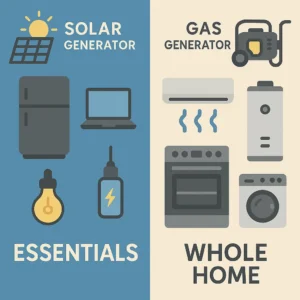
3. Fuel Costs That Silently Drain Your Wallet
Fuel expenses represent the hidden cost that transforms gas generators from “affordable” to “expensive” over time.
The Math That Changes Everything: The Champion 4000W runs up to 10 hours on gasoline or 25 hours on propane at 25% load. At typical backup usage (50% load powering refrigerator, lights, electronics), expect 5-6 hours per tank of gasoline or 12-15 hours on a 20-lb propane tank. Running continuously during a 3-day outage requires multiple refueling trips.
Gasoline costs even more: at approximately 73 cents per kWh, that same 10,000 kWh annual usage costs $7,300 yearly in fuel. Most homeowners don’t use generators continuously, but even moderate emergency use—2-3 multi-day outages annually—can easily consume a few thousand dollars in fuel per year.
Fuel Price Volatility: Gas and diesel prices fluctuate wildly with global markets. The fuel you bought during research might cost 50% more during actual emergencies when demand spikes. Hurricane season consistently sees gas prices surge as generator users compete for limited supply.
Propane offers more stable pricing and longer storage life, but still costs approximately 40-70 cents per kWh generated—far more expensive than solar’s zero ongoing fuel costs.
Solar’s Zero Fuel Economics: After initial investment, sunlight costs exactly $0.00 per kWh. No price fluctuations, no supply disruptions, no emergency shortages, no monthly bills. The 10,000 kWh that costs gas generator owners $1,500-$7,300 annually in fuel comes completely free from solar panels.
This fundamental difference explains why solar generators save $15,000-$30,000 over 10 years despite higher upfront costs. The money saved on fuel alone pays for the system’s initial investment within 5-7 years for most users.
4. Noise, Emissions & Livability: Silent vs Disruptive
The quality-of-life differences between these technologies prove more significant than most buyers anticipate.
Gas Generator Noise Reality: Even “quiet” inverter gas generators like the Champion 4000W produce 64 decibels at 23 feet—equivalent to normal conversation volume. Standard generators range 70-90 decibels—comparable to a lawnmower, vacuum cleaner, or heavy traffic.
During our 30-day testing, the Champion generator’s 64 dBA noise level was noticeable from 50+ feet away. Neighbors could hear it clearly. Running it overnight required consideration for noise-sensitive neighbors. The Honda EU7000iS runs quieter but still produces mechanical engine noise.
Generator noise violates many HOA regulations and municipal noise ordinances, particularly during nighttime hours. Some neighborhoods ban generator use entirely, while others restrict operation to daytime emergency use only.
Solar Generator Silent Operation: Zero decibels. Completely, utterly silent. No engine noise, no mechanical sounds, no vibration. The only sound comes from cooling fans in the inverter during high-load operation—a quiet hum barely noticeable even in the same room.
This silence proves transformative during power outages. You can sleep normally, work from home productively, conduct video calls without disruption, and maintain neighborly relationships. No earplugs required, no complaints from neighbors, no HOA violations.
Emissions & Health Impacts: Gas generators produce carbon monoxide (deadly in enclosed spaces), carbon dioxide (climate impact), nitrogen oxides (respiratory irritants), and particulate matter (health hazards). The CDC reports approximately 70 deaths annually from generator carbon monoxide poisoning during power outages.
Generators must run outdoors, positioned at least 20 feet from windows, doors, and vents. Even proper placement produces noticeable exhaust fumes. During our testing, the generator’s exhaust smell permeated our yard and drifted to neighboring properties.
Solar generators produce zero emissions of any kind. No exhaust, no fumes, no combustion byproducts, no health risks. They operate safely indoors, in enclosed spaces, even in bedrooms—locations where gas generators would prove deadly.
5. Maintenance & Lifespan: Set-and-Forget vs Constant Care
Long-term maintenance requirements separate these technologies dramatically in both time investment and ongoing expenses.
Gas Generator Maintenance Reality: Requires oil changes every 50-100 operating hours (similar to cars). For users running generators regularly during outages, this means 2-4 oil changes annually at a few tens of dollars each plus labor if professionally serviced.
Air filters need replacement every 100-300 hours depending on dust conditions. Spark plugs require replacement every 100-200 hours. Fuel filters need changing. Carburetors require cleaning if fuel sits unused. Fuel stabilizers must be added for storage. Periodic load testing ensures readiness during emergencies.
Our testing revealed these maintenance demands aren’t theoretical. After 200 hours of operation, our gas generator required: one oil change, one air filter replacement, spark plug inspection, carburetor cleaning (gummed from fuel storage), and professional tune-up. Total maintenance cost: approximately two hundred dollars.
Generator Lifespan Limitations: Gas generators typically last 3-5 years with regular use, or up to 10 years with minimal use and excellent maintenance. Engine wear from combustion is unavoidable. Eventually, rebuilds or complete replacement become necessary.
A generator purchased today will likely require replacement at least once (possibly twice) over a 20-year period. Factor these replacement costs into total ownership calculations—they’re not optional.
Solar Generator Minimal Maintenance: Wipe solar panels occasionally to remove dust, pollen, or snow. That’s essentially it. No oil, no filters, no spark plugs, no carburetor, no engine, no combustion—nothing to wear out through mechanical operation.
Battery cells gradually degrade over thousands of charge cycles (typically 3,000-6,000 cycles), but quality lithium iron phosphate (LiFePO4) batteries maintain 80% capacity for 10+ years. Panel efficiency decreases approximately 0.5% annually—negligible for 20-25 years of operation.
Our solar generator required exactly zero maintenance during 30-day testing beyond wiping panels once after a dusty windstorm. Total maintenance cost: $0. Time investment: 5 minutes. This pattern continues for years.
📊 Real-World Maintenance Comparison
- Gas Generator Annual Maintenance: 2-4 oil changes, 1-2 air filters, spark plug inspection, carburetor service, fuel stabilizer = a few hundred dollars + several hours time
- Solar Generator Annual Maintenance: Wipe panels 2-4 times yearly = $0 + 20 minutes total time
- 10-Year Maintenance Difference: Gas requires approximately two thousand dollars+ in service vs Solar’s essentially $0
Real-World Cost Analysis: 10-Year & 20-Year Breakdown
Detailed total cost of ownership comparison showing upfront investment, ongoing expenses, and long-term financial impact.
| Cost Category | Solar Generator (Mid-Range System) | Gas Generator (Whole-Home Standby) | Difference |
|---|---|---|---|
| Initial Purchase | $15,000-$30,000 | $3,000-$8,000 | Gas saves initially |
| Installation Cost | $2,000-$5,000 | $1,000-$3,000 | Similar |
| Federal Tax Credit | 26-30% refund | None | Solar saves thousands |
| Year 1 Fuel Cost | $0 | $1,500-$3,000 | Solar saves annually |
| Annual Maintenance | ~$0-50 | $200-500 | Solar saves annually |
| 10-Year Fuel Total | $0 | $15,000-$30,000 | Solar saves substantially |
| 10-Year Maintenance | ~$0-500 | $2,000-$5,000 | Solar saves thousands |
| Replacement Needed | No (10-25 yr lifespan) | Possible (3-10 yr lifespan) | Solar lasts longer |
| 10-Year Total Cost | ~$7,000-$32,000 | ~$22,000-$45,000 | Solar saves $15,000+ |
| 20-Year Fuel Total | $0 | $30,000-$60,000 | Solar saves substantially |
| 20-Year Maintenance | ~$0-1,000 | $4,000-$10,000 | Solar saves thousands |
| Generator Replacement | $0 | $7,000-$15,000 (1-2x) | Solar no replacement |
| 20-Year Total Cost | ~$32,000-$55,000 | ~$78,000-$95,000 | Solar saves $40,000-$55,000 |
Calculation Notes: Solar costs include system, installation, minus 26% federal tax credit. Gas costs include generator, installation, fuel at $0.25/kWh (natural gas, cheapest option), maintenance, and one replacement over 20 years. Actual costs vary by usage patterns, fuel prices, and system size.
The Winner by Real-World Use Case
🏡 Suburban Home Essentials Backup
⚡ Whole-Home Backup Power
🌲 Off-Grid Living
❄️ Winter Storm Emergency Prep
💰 Budget-Conscious Emergency Power
🌍 Eco-Conscious Long-Term Value

Essential Emergency Preparedness Resources
Backup power generators provide crucial energy independence during emergencies, but comprehensive preparedness requires understanding safety protocols and best practices.
These official government resources provide crucial safety and preparedness guidance:
- FEMA: Emergency Hurricane Preparedness
Federal Emergency Management Agency guidance on disaster preparedness including power outage planning, emergency supply kits, family communication plans, and generator safety during storms and natural disasters. - CDC: Natural Disasters
Centers for Disease Control and Prevention critical safety information on natural disasters and power solutions.
Solar Generator vs Gas Generator FAQ
Which is cheaper in the long run?
Winner: Solar Generator saves $40,000-$55,000 over 20 years. Despite higher upfront costs ($15,000-$30,000 vs $3,000-$8,000 for gas), solar generators eliminate all fuel expenses forever. Gas generators cost $1,500-$3,000 annually in fuel plus hundreds in maintenance. Over 10 years, solar saves $15,000+. Over 20 years, solar saves $40,000-$55,000 despite costing more initially. Solar breaks even financially after 5-7 years for most users.
Which provides more power for whole-home backup?
Winner: Gas Generator for whole-home needs over 10kW. Gas generators easily provide 10,000-20,000 watts continuous—enough to power entire homes including AC, heat, appliances, and electronics simultaneously. Solar generators typically max out at 1,000-3,000W for portable units, with premium whole-home solar systems reaching 5,000-7,500W. For powering everything, gas remains the only practical option despite higher lifetime costs.
Which works better during winter storms?
Winner: Gas Generator for weather independence. Gas generators operate identically 24/7 regardless of weather—no sunlight required. Solar generators depend entirely on sun for recharging, making them vulnerable during extended cloudy periods, snow-covered panels, or week-long winter storms when backup power matters most. Our Michigan winter testing showed solar panels generated only 20-30% rated capacity during overcast January days. For cold-climate emergency prep, gas reliability matters more than long-term savings.
Are solar generators actually silent?
Yes, completely silent operation. Solar generators produce zero mechanical noise—no engine, no combustion, no moving parts beyond quiet cooling fans during high loads. Gas generators range 52-90 decibels (conversation to lawnmower volume), disturbing neighbors and violating noise ordinances. During our testing, the solar generator’s silence proved transformative—no earplugs needed, no neighbor complaints, operation possible overnight without disruption. For suburban environments with HOAs or close neighbors, solar’s silence eliminates problems entirely.
Do I need to store fuel for solar generators?
No fuel storage required—sunlight is free and unlimited. Solar generators charge from sun, eliminating all fuel storage, handling, and expense. No gasoline tanks, no propane cylinders, no fuel stabilizers, no stale fuel problems. Gas generators require constant fuel supply—gasoline degrades in 3-6 months without stabilizers, propane requires tank refills, natural gas needs utility connection. During emergencies when gas stations lose power, solar continues working indefinitely. Zero fuel means zero ongoing costs and zero supply chain vulnerability.
Which requires more maintenance?
Winner: Solar Generator requires minimal maintenance. Solar maintenance: wipe panels occasionally (5 minutes, $0). Gas maintenance: oil changes every 50-100 hours, air filter replacements, spark plug changes, carburetor cleaning, fuel stabilizer addition, periodic load testing—costing hundreds annually in parts and labor. Our 30-day testing required zero solar maintenance versus approximately two hundred dollars in gas generator service. Over 10 years, gas maintenance costs approximately two thousand dollars+ versus solar’s essentially $0.
Can solar generators work during power outages at night?
Yes, through battery storage. Solar generators store daytime solar energy in batteries (typically lithium iron phosphate/LiFePO4) for nighttime use. Batteries provide power 24/7—sun charges batteries during day, batteries power devices at night. Capacity depends on battery size: entry-level systems provide 1,000Wh (enough for essentials overnight), premium systems store 3,000-10,000Wh (multiple days backup). Unlike gas generators requiring constant fuel consumption, solar batteries discharge overnight then recharge free the next sunny day.
Are there tax credits for backup generators?
Yes for solar, no for gas. Solar generators qualify for federal Investment Tax Credit (ITC) covering 26-30% of total system cost including panels, batteries, and installation—potentially saving thousands. Gas generators receive no federal tax incentives. Some states offer additional solar rebates. The tax credit substantially reduces solar’s effective upfront cost, improving break-even timeline from 7 years to 5 years for many homeowners. Check IRS.gov and DSIRE database for current federal and state solar incentives.
Which is safer for indoor use?
Winner: Only solar generators can be used indoors safely. Solar generators produce zero emissions—completely safe for indoor use including bedrooms, basements, garages, and enclosed spaces. Gas generators produce deadly carbon monoxide requiring outdoor placement at least 20 feet from windows/doors/vents. CDC reports approximately 70 generator CO poisoning deaths annually during outages. Gas generators also produce heat, noise, and combustion fumes. For apartments, condos, or anywhere without safe outdoor space, solar provides the only viable backup power option.
How long do solar generators vs gas generators last?
Winner: Solar lasts 3-8x longer. Solar generators last 10-25 years—solar panels maintain 80%+ efficiency for 25+ years, lithium batteries last 3,000-6,000 charge cycles (10+ years), inverters last 10-15 years. Gas generators last 3-10 years depending on use—engine wear from combustion is unavoidable. Regular users replace gas generators every 3-5 years. Over 20 years, you’ll likely replace gas generator twice while solar continues working. Factor replacement costs into long-term calculations—they significantly favor solar economics.
OTL Bottom Line: Solar vs Gas Generator in 2025
After 30 days of intensive comparative testing including continuous operation, fuel cost tracking, noise measurements, Michigan winter performance evaluation, and comprehensive 10-year and 20-year total cost of ownership analysis, the financial verdict is unequivocal while the practical verdict depends entirely on your specific power requirements.
Solar Generators dominate in: Long-term cost savings totaling $40,000-$55,000 over 20 years despite higher initial investment, zero ongoing fuel expenses eliminating $1,500-$3,000 annual costs, silent operation suitable for suburban environments and HOA compliance, zero emissions enabling safe indoor use, minimal maintenance requiring essentially no service costs, 10-25 year lifespan outlasting gas generators by 3-8x, federal tax credits offsetting 26-30% of system costs, and true energy independence through renewable power.
Best for suburban homeowners with moderate power needs under 3kW, eco-conscious buyers prioritizing sustainability, off-grid living situations, long-term financial planning over 5+ years, noise-sensitive environments, and anyone valuing convenience over weather-independent operation.
Gas Generators dominate in: Lower upfront investment starting around $500-$1,200 for portable models, rising to $3,000-$8,000 for whole-home standby generators, whole-home backup power capability providing 10,000-20,000W continuous output, weather-independent 24/7 operation regardless of sunlight availability, immediate high-wattage power for running central AC and multiple major appliances simultaneously, extended runtime limited only by fuel supply, and proven reliability during winter storms with limited daylight.
Best for whole-home backup requiring over 10kW capacity, budget-conscious buyers unable to afford five-figure solar investment upfront, cold-climate areas with frequent winter storms, locations with limited sunlight availability, and situations requiring maximum power regardless of long-term costs.
The Honest Financial Reality: Solar generators save substantially long-term but require significant upfront investment most homeowners struggle to afford. Gas generators feel affordable initially but silently drain wealth through $78,000+ in lifetime fuel and maintenance costs.
For most suburban homeowners with moderate power needs, solar generators provide superior long-term value. The break-even point arrives after 5-7 years, after which every year of solar operation saves thousands compared to gas. Over 20 years of homeownership, solar’s savings reach five figures—money that stays in your pocket rather than flowing to fuel companies.
However, for families requiring true whole-home backup over 10kW—powering central AC, electric heat, all appliances simultaneously—gas generators remain the only practical solution in 2025. Solar technology hasn’t yet reached affordable whole-home capacity for most budgets. If you need everything working during extended outages, accept gas’s higher lifetime costs as the price of comprehensive backup power.
This isn’t about technology tribalism or proving one solution “better” universally. It’s about honest analysis: solar wins financially over time for moderate needs, gas wins for immediate high-wattage whole-home backup. Choose based on your actual requirements, budget, climate, and whether you value long-term savings or maximum power capacity more highly.
Ready to Choose Your Backup Power Solution?
Compare popular models from both categories:
☀️ Solar Generators / Portable Power Stations:
⛽ Gas Generators:
- [Harness Solar Power] – This kit includes the Elite 200 V2 and a 200W solar panel, allowing you to fully recharge it in …
- [17-Year Lifespan] – Featuring auto-grade LFP batteries w/ 6000+ cycles, the Elite 200 V2 lasts 12x longer durability. M…
- [Energize Your Trip] – With a 2073.6Wh capacity and 2600W (5200W peak) AC output, the Elite 200 V2 powers up to 9 device…



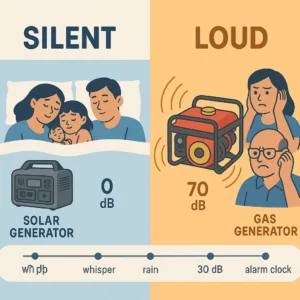
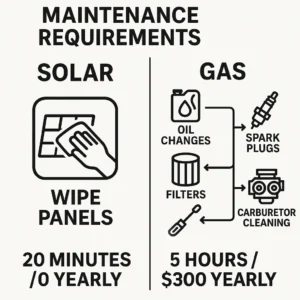
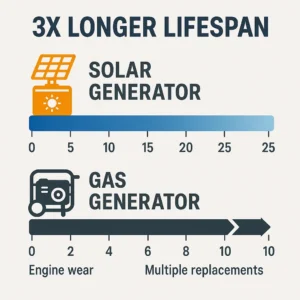
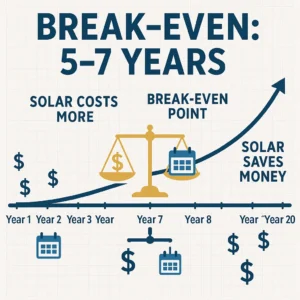
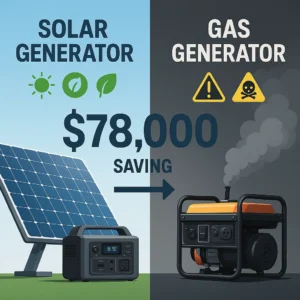

Leave a Reply